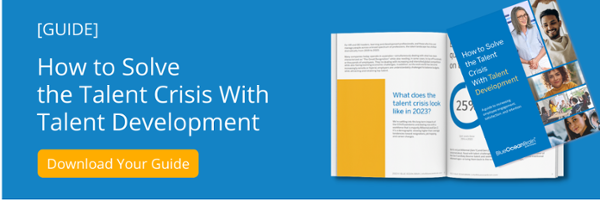Many companies are encountering a shortfall of experienced leaders. There is a need for more employees adept at gathering, analyzing, and developing plans based on data. More employees who are comfortable with technology. More employees who are at ease with change and ambiguity. And more staff with strong soft skills—like emotional intelligence, conflict management, and communication.
And while hiring teams may know what they need, all too often, they have a tough time finding, onboarding, and retaining that talent. As they spin their wheels and endure a revolving door of onboarding and offboarding talent during an environment where employee disengagement and turnover have become hot topics, there's one critical area that’s often overlooked: talent development.
Impact of talent development on engagement and retention
Instead of looking externally for new talent, what if you focused more on internal efforts—on developing (and, subsequently, retaining) the employees you already have?
Companies and their people benefit from talent development. Organizations end up with a more engaged, productive, and loyal workforce. And employees benefit from personal and professional growth that can help them excel in a competitive environment.
It's important to remember that not only do these inherent benefits exist, but employees are also increasingly demanding development and training from employers. In fact, an EdAssist survey indicates around 60% of professionals say they'd select a job with professional development opportunities over regular pay raises. That research also shows that many opt to leave for companies that are offering development opportunities.
Engage them before they go
Disengaged employees may already be on their way out the door if they haven’t just given up while on the job and joined the ranks of “quiet quitters”—those employees who are physically at work but mentally somewhere else, putting in just the minimum to get by Gallup suggests that around 50% of U.S employees fall into this category,
Engaging employees now, while you still have them on the job, can help you keep them and help ensure that they are productive and committed to the company and their work.
The keys to cultivating and nourishing talent internally
What does it take to nurture and nourish talent internally? Something different. The old methods of training and development that were widely in use pre-pandemic—live in-person training or even synchronous online training—simply don’t offer the convenience and flexibility of today’s more accessible and customizable options.
Modernizing training and development efforts can increase participation and learning outcomes—boosting the ROI of training investments.
How to get better ROI from L&D
Give them what they need and want
Employees want to learn, but they also want to learn what they want to learn. Providing them with a wide range of training options on topics that interest them personally and professionally can help keep them engaged and motivated. As McKinsey says:
“An honest appraisal of employee needs, supported by data, helps to ensure that a company has a clear-eyed view of the core theme it is driving.”
Yes, managers should work with employees to help identify learning gaps for today's and tomorrow's business needs, but this should be a collaborative process to help align employees' interests with company needs.
At Blue Ocean Brain, we know the value and power of weaving the learning people crave with the learning people need. Lessons on stress management and communication can draw people in, where they can then "bump into" and engage with learning on inclusion, critical thinking, and resilience.
Engage managers in the process
Speaking of managers, it’s critical to involve them directly in the training and development process. Managers need to know not only what is required in terms of employee training and development efforts but why these efforts are critical. What are the benefits for employees and the organization, and how can they best position themselves as catalysts in the process?
Managers need to think like marketers
Engaging both employees and managers in development efforts requires selling them on the value of training and development. The critical thing consumers—and employees—want to know when considering an offer is what’s in it for them. So, why should employees and managers embrace your company’s training efforts? Communication efforts need to focus on multiple options for access, as well as the personal and professional value training and development have to offer.
Managers need to be flexible in access, delivery, and content
The old paradigm of gathering all employees in one place at a particular place and time doesn’t work in today’s environment.
- Not all employees work in the same place.
- Not all employees work at the same time.
- Not all employees need or are interested in the same information.
Increasingly, most employees want the freedom and flexibility to access training and information when and where they need it. Immediate, seamless access to up-to-date, practical, and valuable information is the name of the game in 2023. If you can deliver that to your employees, you can not only cultivate and nourish talent—you can keep that talent on board and engaged.
Managers need to show value to employees
If you can convince employees of the value of your L&D offerings, engage them, and keep them engaged, you will have higher retention rates and avoid the revolving door that many companies are dealing with today.
Need more talent development tips?
Check out our new ebook, Solving the Talent Crisis With Talent Development, which provides a snapshot of the current workplace challenges and actionable steps you can take to combat low engagement and high turnover. Start attracting and retaining better talent!




![[New eBook] Solving the Talent Crisis with Talent Development](https://blog.blueoceanbrain.com/hs-fs/hubfs/how-to-solve-the-talent-crisis.png?width=760&name=how-to-solve-the-talent-crisis.png)
